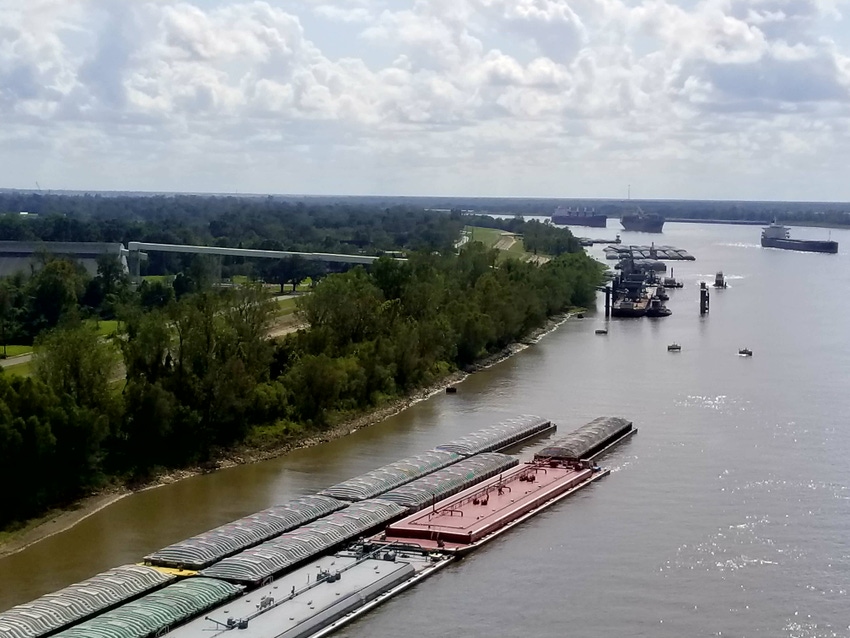NESP will enhance U.S. agricultural competitiveness by constructing seven 1,200 ft. locks and dams on Upper Mississippi River-Illinois Waterway System.
October 30, 2020

A bipartisan, bicameral group of U.S. lawmakers is leading a push to fund the modernization of inland waterway infrastructure along the Upper Mississippi and Illinois rivers. In a letter to the U.S. Army Corps of Engineers, Reps. Cheri Bustos (D., Ill.) and Jason Smith (R., Mo.) and Sens. Dick Durbin (D., Ill.) and Roy Blunt (R., Mo.) urged the Corps to include construction funding for the Navigation & Ecosystem Sustainability Program (NESP) in its fiscal 2021 work plan. The program would modernize and expand seven outdated locks and restore ecosystems.
As the most cost-efficient mode of transporting agricultural products, the inland waterway system is critical to the transportation of U.S. soybeans and plays a key role in the agricultural economy.
NESP, which was authorized in Title VIII of the Water Resources Development Act of 2007, would modernize and expand seven outdated locks and restore ecosystems. Including construction funding for NESP would build on the $4.5 million investment in preconstruction engineering and design (PED) for the projects in fiscal 2020.
“NESP is a critically important, multipurpose program that allows the Corps to address both navigation and ecosystem restoration in an integrated approach that construct new locks at seven existing sites, thereby opening the river up to two-way traffic,” the lawmakers wrote. “Our nation’s water infrastructure plays a critical role in maintaining our competitiveness in the global economy by ensuring the safest, least expensive, most environmentally friendly and most efficient movement of goods to market, but the current backlog of outstanding water infrastructure projects pending before the Corps is putting that competitiveness at risk.”
Tracy Zea, president and chief executive officer of the Waterways Council Inc., said, “This window in time, with a new construction start available, is the best opportunity to begin the long-awaited NESP program. Waterways Council Inc. and its members greatly appreciate the leadership from Congresswoman Bustos, Congressman Smith, Sen. Blunt, Sen. Durbin and all who co-signed onto this letter advocating for this critical program for the entire nation. America’s farmers, our manufacturing base and our construction trades need NESP to begin now.”
Bobby Frederick, vice president of legislative affairs and public policy for the National Grain & Feed Assn., commended the lawmakers for the letter, saying, “NESP will make American agriculture more competitive through the construction of seven new 1,200 ft. locks and dams on the Upper Mississippi River & Illinois Waterway. This additional capacity will reduce potential commercial barge traffic disruptions, help discipline rail rates and alleviate highway congestion, all while transporting commodities via the most environmentally friendly mode.”
“With over 50% of all corn for export being transported on the inland waterway system, corn farmers rely heavily on efficient and reliable infrastructure of locks and dams,” said National Corn Growers Assn. president John Linder, who expressed thanks to the legislators for bringing attention to this important issue to “ensure our growers are able to move their product efficiently and stay competitive.”
Bill Gordon, president of the American Soybean Assn. and soy farmer from Worthington, Minn., added, “As America’s number-one export crop with an average export value of more than $16 billion, we rely on U.S. inland waterways infrastructure to stay competitive in dynamic global markets. The American Soybean Assn. appreciates the Corps’ previous allocation of funds through NESP to improve locks along the Upper Mississippi and Illinois rivers, and we again look to the Corps to assure these vital improvements come to fruition through the [2021 work plan]. As America’s soybean farmers are harvesting the 2020 crop this fall, the timeliness of these water infrastructure projects is all the more evident — and pressing — for our continued economic success.”
You May Also Like

.png?width=300&auto=webp&quality=80&disable=upscale)

